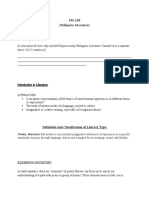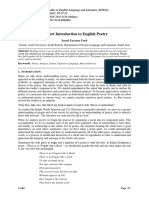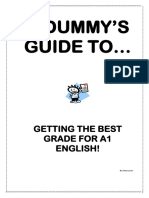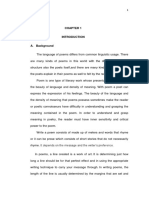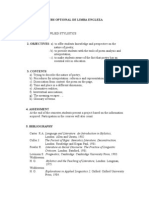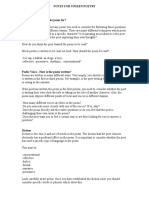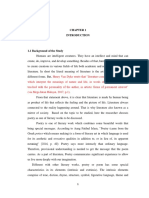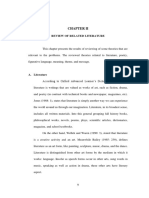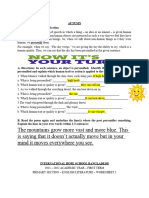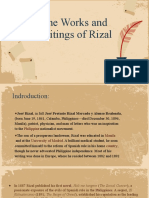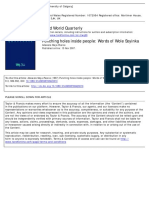library.uns.ac.id digilib.uns.ac.
id
A structural analysis of william wordsworth’s poems
By:
Astrie Nurdianti Wibowo
K 2203003
CHAPTER I
INTRODUCTION
A. The Background of the Study
The material or subject matter of literature is something very general, such as
man’s fate, or human life. This implies that literature can deal with every human
activity, or human experience. Some of these activities are peculiar; some are
widespread, while some are universal. Therefore, people expect that literature which
is the record of human experience, to its subject, make a varying appeal to people of
other communities (Frederik, 1988:1). These theories support if there is a statement
that all of those experiences can be presented well through literary work. Literature
brings some values through people’s lives such as the increasing of their sense about
their surroundings and the increasing of their sensitivity. And it is helping them to
understand better other and themselves.
Literature is an interesting field in which the process of its composition needs
creative intelligence and imagination performed through language. Frederik (1988)
also says that literature is fundamentally an expression of life through the medium of
language. There is about not only writing, but also the way of how to perform the
expression through words as a vital record of what men have seen in life, what they
�library.uns.ac.id digilib.uns.ac.id
have experienced of life and all about what they have thought and felt about every
single thing which have the most enduring interest of human being. In this case, the
writer of literary work from his own experiences—both observed and imagined
experiences—selects, combines and organizes to create new experiences for his
reader. With his creative thoughts, the readers or the audiences are brought to find
more expected experiences. This makes literary work is different with the other field;
it is all because even its creation process and interpretation need better understanding
and competence of the world of literature.
Like human being, each work of literature has its individual characteristics.
Poems as well as other forms of literature, besides fiction and drama have its own
ways of conveying the whole meaning. Daiches (1984) states that poetry is at once
the most simple and the most complex form of literary expression. It is simple
because represent directly and spontaneously. It is complex in its utility of the varied
resources of language which is more richly and fully than other works. It is also to be
called complex because combines the appeal to the ear with the appeal to the mind
equally. And it uses all kinds of overtone and suggestion to convey what might be
called the feel and quality of a situation at the same time it presents its overt meaning.
It means that the language used in poem is more condensed than the language used in
such as fiction and drama which mostly use our daily language.
Language used in poem is different from the language of our daily
communication that gives straight meaning of some information. The language of
poem consists of many layers of meaning. It has ambiguity, homonymy and
connotative words. Determining the sense of a word by its context is probably the
�library.uns.ac.id digilib.uns.ac.id
most important skill in reading a poem and the first step in achieving that skill is to
take seriously about the meaning of the word that is still vague and confusing. The
reader should use a good dictionary as reference. It is a skill that one should have in
understanding a poem, on the contrary, in daily speech and reading ones are
constantly picking the correct one of the many senses that ordinary words possess.
For example during a conversation about pet, people automatically know when
someone says “dove” that he is referring to a kind of bird. But, when the reader is
reading more difficult material like poetry, he sometimes is unable to determine the
sense of meaning the word “dove” so immediately and correctly. It may be that the
reader does not know the specific sense in which the word is being used because it is
“poetic”. We can see that the language used in poem is more complex in meaning
than daily language. Even more, the meaning offered is not as clear as the meaning in
fiction or even drama which is played on stage so that is easier to be understood.
A poem is a composition that makes the readers think about words and their
arrangement (Pickering, 1982, 698). Words are the only material of a poem.
Sometimes we find a poem less than ten lines; the problem is that how words can, in
a view lines, cover the idea that represents the experiences and creates a new
experience to his reader. A poem is not only about words in line, but also creativities
in arranging and choosing the words so that there is not queer if a word may has so
many dimensions of meaning.
Actually, every literary work is a structure which is built by some elements.
These elements are interdependent to each other. In other words, the elements are
related to each other and make wholeness or unity. Poem expresses the idea in line by
�library.uns.ac.id digilib.uns.ac.id
using diction, imagery, rhyme, rhythm, pattern, sound and sense, and tone as the
elements of poem. The elements in poem have a role in process of arrangement. It
means that the elements take a part in consideration of the poet in his writing process.
So that by following the role of the elements which interdependent to each other,
there is possible a poem, even in a view lines, can present the whole things intended
by the writer beautifully.
To be able to analyze a literary work, some one has to have some kind of
knowledge or sciences in literary analysis. There are many methods of analysis which
include structural analysis, biographical analysis, psychological analysis, and
sociological analysis. Each of the methods has its own characteristics. For example,
structural analysis focuses to analyze the elements of the literary work itself,
biographical analysis is focused on the creator of the works, while psychological
analysis attempts to analyze the psychology of the characters, and sociological
analysis focuses to analyze literary work based on the social background.
Based on some methods mentioned above, there are two approaches which can
be used to explore the experience of literature. The first is extrinsic study and the
second is extrinsic study. Extrinsic study attempts to interpret literature in the relation
with other factors outside of the text which influence the work; all histories, all
environment factors, which can be argued to shape the literary work. Some
approaches included in this study are biographical, psychological, sociological, moral
etc. While intrinsic study is the interpretation and analysis in the literary work itself.
A work of art is considered as a whole system of structure and served for
aesthetic purpose. Structure is the concept including both content and form. So far
�library.uns.ac.id digilib.uns.ac.id
they are organized for aesthetic purpose. Intrinsic study sees that the work of art
stands by itself without being related to the factors outside or social reality of the
world. Therefore in analyzing the literary work researcher only focuses on the
elements of the work that form structure as a unity, in which it is called a structural
approach. The researcher can interpret a poem by analyzing every single of the
elements, and then combining and analyzing the relationship of one element to the
other. It because of each element has interdependence to the other elements and that
is the way of the elements of poem makes a unity.
In this research the writer uses structural approach to analyze poems of William
Wordsworth. According to Foerster and Falk in the American Poetry and Prose
(1982), William Wordsworth is one of great poets in romantic period. The period
where the felling-love-the heart were praised, the goodness of human nature and the
virtue of the man of feeling was proclaimed, the sentimentalism was changed into
something rich and strange, and the feeling became far more genuine, complicated,
and interesting.
William Wordsworth is one of popular poets of romantic period. He was born
on April 7, 1770, at Cockermouth on the River Derwent, in the heart of the Lake
District. Wordsworth and his beloved sister Dorothy moved to Alfoxden House,
which had the important virtue of being only a few miles from Coleridge's home at
Nether Stowey. This marks the beginning of the so-called "annus mirabilis," the year
of intense creative partnership that would result in the first edition of Lyrical Ballads
which was published in 1978. He wrote the second edition of his lyrical ballads in
1800. In the same time, Wordsworth was also working on what would become books
�library.uns.ac.id digilib.uns.ac.id
I and II of ‘The Perlude’. A third edition of Lyrical Ballads, with an expanded
preface, came out in 1802. There were other poems like The Lucy Poem, Tintern
Abbey, London, etc. Wordsworth’s famous poem about daffodils was composed in
1804, two years after he saw the flowers on a stormy day with Dorothy. Wordsworth
published his poem, “I wandered lonely as a Cloud”, in 1807. He later altered it, and
his second version, published in 1815, is the one widely known today. And many
other poems of Wordsworth that become his great works. In this study, the researcher
is going to analyze five poems in the different year of writing, those are: She Dwelt
Among the Untrodden Ways (1799), I Traveled Among Unknown Men (1801), My
Heart Leaps up when I Behold (1802), The Sun has Long been Set (1804), I
Wandered Lonely as a Cloud (1815).
At the first reading or hearing, it may be to be simple. When the reader reads a
poem, for the first time, she will get certain kind of sense that comes through to her
immediately. This sense comes to the reader as a literal meaning or literal facts of a
poem, and it is called the plain sense.
The plain sense of “She Dwelt Among the Untrodden Ways” tells about a
woman lives unknown of the eyes, no one praises her till her dead. Then in the first
reading of “I Traveled Among Unknown Men” the plain sense tells that the speaker
traveled in the land that he has never been there before. It just like his melancholy
dream that he really loves it, but actually the land is not to be the same again, there is
no green that Lucy can see anymore. The third is “My Heart Leaps up when I
Behold”, it tells about the admiration of the beauty of rainbow in the sky along the
author’s life, when the author began his life then grew up and till he died. Fourth,
�library.uns.ac.id digilib.uns.ac.id
“The Sun has Long been Set” tells that there is a night with stars on the sky, little bird
among the bush and trees, there are also flowers named cuckoo and thrushes, in far
the wind sound as rush and the water that gushes, those all fill the hollow of the sky
and become the joy itself. The last is plain sense of “I Wandered Lonely as a Cloud”
tells about a man who is feeling alone, and then in his loneliness he is admired by the
beauty of ten thousands of golden Daffodils, he sees the Daffodils are dancing beside
the lake, they seems the stars on the milky way, there is so much feeling of
amazement and it makes him to gaze and gaze, and finally his remembrance of
beautiful Daffodils fills his loneliness with pleasure.
The reader just got a plain sense of those five poems in the first reading. But
after reading more carefully and getting better acquaintance, she realizes that it is not
completely right. More over, with literary knowledge and sense, there will be many
questions appear in mind such as why this word is chosen by the poet, what is the
function of words repetition on the third stanza, why this word ordered as a figure of
speech and so on. Hence, the reader is motivated to find out that each of five poems
above is not only a series of words but it is meaningful one.
There is much more hidden meaning and many layers of poem have not been
discovered yet. Because of this reason which is supporting the researcher to choose
“She Dwelt Among the Untrodden Ways”, “I Traveled Among Unknown Men”, “My
Heart Leaps up when I Behold”, “The Sun has Long been Set”, and “I Wandered
Lonely as a Cloud” as works of art, created by a great poet in romantic periods, to be
analyzed. The researcher is eager to know the words used by Wordsworth in his
poems so that can to present his feeling nicely, and to find out the deep meaning of
�library.uns.ac.id digilib.uns.ac.id
the poems by observing the elements that work on it. She assumes that the whole
meaning of a poem is built up by the interrelatedness of its elements which are
diction, imagery, rhyme, rhythm, pattern, sound and sense, and tone. She also
assumes that without realizing how those elements fit with other parts, it means
analyzing of a poem destructive and meaningless.
In this study, dealing with the quotation above, the researcher wants to analyze
poems: “She Dwelt Among the Untrodden Ways”, “I Traveled Among Unknown
Men”, “My Heart Leaps up when I Behold”, “The Sun has Long been Set”, and “I
Wandered Lonely as a Cloud” by using the structural approach in order to find the
elements (diction, imagery, rhyme, rhythm, pattern, sound and sense, and tone) is
unified and coherent.
B. The Statements of the Problem
The problems which will be formulated are as follows:
1. How do the elements of William Wordsworth’s poems are unified and then make
coherences?
2. How do the coherences of the elements in William Wordsworth’s poems build
general meaning?
C. The Objectives of the Study
The objectives of this study are:
1. To reveal how the elements of William Wordsworth’s poems are unified and
make coherence.
�library.uns.ac.id digilib.uns.ac.id
2. To reveal how the coherence of the elements in William Wordsworth’s poems
build the general meaning.
D. The Benefits of the Study
The benefits of the study expected are: Theoretically, the result this study will
give illumination to the ways of understanding poems from the structural approach. It
helps the reader who is interested in how to interpret correctly the poem as one of
literary work by using the elements to get the whole meaning of the poem.
Practically, the result of the study can give the contribution to the teacher in the
way to handle the subject of literature, especially in teaching poetry through
structural analysis.

